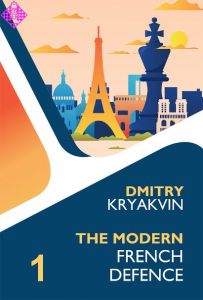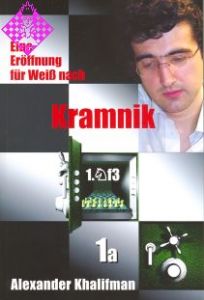Artikelnummer
LOKHAOFWATA4
Autor
Opening for White according to Anand - Vol. 4
399 Seiten, kartoniert, Chess Stars, 1. Auflage 2005
Vorübergehend ausverkauft
The fourth book of the series "Opening for White According to Anand 1.e4" is devoted to opening schemes, which arise after the moves 1.e4 d6, or 1.e4 g6. These positions are so diverse strategiand so rich tactically that they deserve a separate volume.
It is worth mentioning that contrary to some other openings, like for example the Ruy Lopez, the Sicilian Defence, the Petroff Defence, or the Caro - Kann Defence, these openings are not so popular in the top-class tournaments. World's best players try those flank set-ups only very seldom. Gary Kasparov was very skeptical about his opponent's opening choice, while commenting his brilliant win against Veselin Topalov in Wijk aan Zee 1999. Still, we must acknowledge for fairness sake that White did not have any serious advantage as a result of the opening in that game. The chess-world however, is not confined only to Wijk aan Zee and Linares, and it is essential to understand that flank openings are quite popular among chess players at lower levels.
We have to emphasize how special the situation with the flank openings is, by noting that plenty of systems, which have been analysed in our book, have not been even named yet. These systems have proved their right of existence, beyond any doubt, dethe numerous attempts to refute them once and for all. They are not called "Irregular Openings" anymore; nevertheless there is no consent about how they should properly be named. What are the specific features of those systems?
Black avoids early clashes that are so typical for openings in which he fights for the centre right from the beginning of the game. He prefers to narrow his "sphere of influence" to only three ranks and thus presents White with a powerful centre and extra space. Black usually tries first to complete his development and he fianchettoes his dark squared bishop most of the times. He begins active operations in the centre and on the queenside only later. We cannot define such approach as classical at all. As early as during the times of the hyper-modernists, when opening systems for White like Nf3-g3-Bg2 became popular, it was considered that White can experiment freely in the opening due to the advantage of having the first move. Similar experiments for Black have always been reas extremely dangerous and accordingly condemned. It was only during the second half of the 20th century that thanks to the efforts of some non-conformists, and you are going to find their names mentioned quite often in this book, the flank systems were proved to be respectably vital. Black's position is often similar to a coiled spring and his harmonious development enables him to atoften White's powerful centre successfully. So, are really openlike 1.e4 d6 or 1.e4 g6 as good as the Ruy Lopez, or the Sicilian Defence? Well, yes, but maybe not quite...
Preface
It is worth mentioning that contrary to some other openings, like for example the Ruy Lopez, the Sicilian Defence, the Petroff Defence, or the Caro - Kann Defence, these openings are not so popular in the top-class tournaments. World's best players try those flank set-ups only very seldom. Gary Kasparov was very skeptical about his opponent's opening choice, while commenting his brilliant win against Veselin Topalov in Wijk aan Zee 1999. Still, we must acknowledge for fairness sake that White did not have any serious advantage as a result of the opening in that game. The chess-world however, is not confined only to Wijk aan Zee and Linares, and it is essential to understand that flank openings are quite popular among chess players at lower levels.
We have to emphasize how special the situation with the flank openings is, by noting that plenty of systems, which have been analysed in our book, have not been even named yet. These systems have proved their right of existence, beyond any doubt, dethe numerous attempts to refute them once and for all. They are not called "Irregular Openings" anymore; nevertheless there is no consent about how they should properly be named. What are the specific features of those systems?
Black avoids early clashes that are so typical for openings in which he fights for the centre right from the beginning of the game. He prefers to narrow his "sphere of influence" to only three ranks and thus presents White with a powerful centre and extra space. Black usually tries first to complete his development and he fianchettoes his dark squared bishop most of the times. He begins active operations in the centre and on the queenside only later. We cannot define such approach as classical at all. As early as during the times of the hyper-modernists, when opening systems for White like Nf3-g3-Bg2 became popular, it was considered that White can experiment freely in the opening due to the advantage of having the first move. Similar experiments for Black have always been reas extremely dangerous and accordingly condemned. It was only during the second half of the 20th century that thanks to the efforts of some non-conformists, and you are going to find their names mentioned quite often in this book, the flank systems were proved to be respectably vital. Black's position is often similar to a coiled spring and his harmonious development enables him to atoften White's powerful centre successfully. So, are really openlike 1.e4 d6 or 1.e4 g6 as good as the Ruy Lopez, or the Sicilian Defence? Well, yes, but maybe not quite...
Preface
| EAN | 954878243X |
|---|---|
| Gewicht | 460 g |
| Hersteller | Chess Stars |
| Breite | 14,5 cm |
| Höhe | 21 cm |
| Medium | Buch |
| Erscheinungsjahr | 2005 |
| Autor | Alexander Khalifman |
| Sprache | Englisch |
| Auflage | 1 |
| ISBN-10 | 954 8782 43 X |
| Seiten | 399 |
| Einband | kartoniert |
007 Preface
Part 1.
1.e4 d6 2.d4
010 1 various without 2...Nf6
018 2 2...Nf6 3.Nc3 various
023 3 2...Nf6 3.Nc3 Nbd7
035 4 2...Nf6 3.Nc3 e5 4.dxe5 dxe5 5.Qxd8 Kxd8 6.Bg5 without 6...Be6
045 5 2...Nf6 3.Nc3 e5 4.dxe5 dxe5 5.Qxd8 Kxd8 6.Bg5 Be6 7.0-0-0 Ke8;
7...Kc8; 7...Nbd7 8.f4 exf4 9.Nf3 without 9...h6
056 6 2...Nf6 3.Nc3 e5 4.dxe5 dxe5 5.Qxd8 Kxd8 6.Bg5 Be6 7.0-0-0 Nbd7 8.f4 exf4 9.Nf3 h6
Part 2.
1.e4 d6 2.d4 Nf6 3.Nc3 c6 4.f4
067 7 various without 4...Qa5
089 8 4...Qa5 5.Bd3 without 5...e5
096 9 4...Qa5 5.Bd3 e5 6.Nf3 exd4
102 10 4...Qa5 5.Bd3 e5 6.Nf3 Nbd7
108 11 4...Qa5 5.Bd3 e5 6.Nf3 Bg4 7.Be3 without 7...Nbd7
117 12 4...Qa5 5.Bd3 e5 6.Nf3 Bg4 7.Be3 Nbd7
Part 3. Pirc Defence
1.e4 d6 2.d4 Nf6 3.Nc3 g6 4.f4
134 13 various without 4...Bg7
139 14 4...Bg7 5.Nf3 without 5...c5 and 5...0-0
155 15 4...Bg7 5.Nf3 c5
168 16 4...Bg7 5.Nf3 0-0 6.Bd3 without 6...Bg4, 6...Nc6, and 6...Na6
199 17 4 ...Bg7 5.Nf3 0-0 6.Bd3 Bg4
209 18 4 ...Bg7 5.Nf3 0-0 6.Bd3 Nc6
234 19 4...Bg7 5.Nf3 0-0 6.Bd3 Na6 7.0-0 Nb4; 7...c5 8.d5 without 8 ...Bg4 and 8...Rb8
248 20 4 ...Bg7 5.Nf3 0-0 6.Bd3 Na6 7.0-0 c5 8.d5 Bg4
259 21 4 ...Bg7 5.Nf3 0-0 6.Bd3 Na6 7.0-0 c5 8.d5 Rb8
Part 4. Modern Defence
1.e4 g6 2.d4
271 22 various; 2 ...Bg7 3.Nc3 without 3...c5 and 3...d6
290 23 2 ...Bg7 3.Nc3 c5
302 24 2 ...Bg7 3.Nc3 d6 4.f4 various
313 25 2 ...Bg7 3.Nc3 d6 4.f4 Nd7
321 26 2 ...Bg7 3.Nc3 d6 4.f4 Nc6
348 27 2 ...Bg7 3.Nc3 d6 4.f4 c6
372 28 2 ...Bg7 3.Nc3 d6 4.f4 a6
394 Index of Variations
Part 1.
1.e4 d6 2.d4
010 1 various without 2...Nf6
018 2 2...Nf6 3.Nc3 various
023 3 2...Nf6 3.Nc3 Nbd7
035 4 2...Nf6 3.Nc3 e5 4.dxe5 dxe5 5.Qxd8 Kxd8 6.Bg5 without 6...Be6
045 5 2...Nf6 3.Nc3 e5 4.dxe5 dxe5 5.Qxd8 Kxd8 6.Bg5 Be6 7.0-0-0 Ke8;
7...Kc8; 7...Nbd7 8.f4 exf4 9.Nf3 without 9...h6
056 6 2...Nf6 3.Nc3 e5 4.dxe5 dxe5 5.Qxd8 Kxd8 6.Bg5 Be6 7.0-0-0 Nbd7 8.f4 exf4 9.Nf3 h6
Part 2.
1.e4 d6 2.d4 Nf6 3.Nc3 c6 4.f4
067 7 various without 4...Qa5
089 8 4...Qa5 5.Bd3 without 5...e5
096 9 4...Qa5 5.Bd3 e5 6.Nf3 exd4
102 10 4...Qa5 5.Bd3 e5 6.Nf3 Nbd7
108 11 4...Qa5 5.Bd3 e5 6.Nf3 Bg4 7.Be3 without 7...Nbd7
117 12 4...Qa5 5.Bd3 e5 6.Nf3 Bg4 7.Be3 Nbd7
Part 3. Pirc Defence
1.e4 d6 2.d4 Nf6 3.Nc3 g6 4.f4
134 13 various without 4...Bg7
139 14 4...Bg7 5.Nf3 without 5...c5 and 5...0-0
155 15 4...Bg7 5.Nf3 c5
168 16 4...Bg7 5.Nf3 0-0 6.Bd3 without 6...Bg4, 6...Nc6, and 6...Na6
199 17 4 ...Bg7 5.Nf3 0-0 6.Bd3 Bg4
209 18 4 ...Bg7 5.Nf3 0-0 6.Bd3 Nc6
234 19 4...Bg7 5.Nf3 0-0 6.Bd3 Na6 7.0-0 Nb4; 7...c5 8.d5 without 8 ...Bg4 and 8...Rb8
248 20 4 ...Bg7 5.Nf3 0-0 6.Bd3 Na6 7.0-0 c5 8.d5 Bg4
259 21 4 ...Bg7 5.Nf3 0-0 6.Bd3 Na6 7.0-0 c5 8.d5 Rb8
Part 4. Modern Defence
1.e4 g6 2.d4
271 22 various; 2 ...Bg7 3.Nc3 without 3...c5 and 3...d6
290 23 2 ...Bg7 3.Nc3 c5
302 24 2 ...Bg7 3.Nc3 d6 4.f4 various
313 25 2 ...Bg7 3.Nc3 d6 4.f4 Nd7
321 26 2 ...Bg7 3.Nc3 d6 4.f4 Nc6
348 27 2 ...Bg7 3.Nc3 d6 4.f4 c6
372 28 2 ...Bg7 3.Nc3 d6 4.f4 a6
394 Index of Variations
Die Reihe "Opening for White according to Anand 1.e4" des russiWeltklassespielers Alexander Khalifman entwickelt sich immer mehr zu einem beeindruckenden Mammutwerk, wobei sowohl die Qualität als auch der Umfang der Arbeit hervorstechen.
Nach den beiden Auftakt-Bänden über offene Eröffnungen und dem Band über Caro-Kann und Skandinabeschäftigt sich der nun vorlievierte Band mit dem ThemenPirc- / Moderne Verteidi
Bekanntlich geht es bei dieser Reidarum, ein auf 1.e4 aufbauendes aussichtsreiches Weiß-Repertoire zu erstellen. Es handelt sich also auch bei dieser Fortsetzung "nur" um ein Repertoirebuch, aber dass Khalifman satte 400 (!) prall gefüllte Seiten für ein Repertoire gegen 1...d6 bzw. 1...g6 benötigt, zeigt deutlich, wie ausführlich und akribisch er wiederzu Werke ging.
Das untersuchte Repertoire detailvorzustellen würde den Rahmen dieses Artikels sprengen, deshalb wollen wir uns auf einige Beispiele beschränken.
Zunächst steht der Block über 1.e4 d6 2.d4 auf dem Programm. Nach einigen Kapiteln über seltenere Variwie z.B. 2...Sf6 3.Sc3 Sbd7, wogegen Khalifman 4.g4 untersucht, folgt der erste große Block über 2...Sf6 3.Sc3 c6 4.f4, wonach in der Regel ein Aufbau mit 5.Ld3, 6.Sf3 und 7.Le3 folgt.
Im dritten Teil des Buches ist dann die Pirc-Verteidigung an der Reihe, nach 2...Sf6 3.Sc3 g6 konzentriert sich der Autor auf 4.f4.
Hierzu zwei Ausschnitte: nach 4...Lg7 5.Sf3 c5 6.Lb5+ Ld7 behanKhalifman die Fortsetzung 7.Lxd7+, während er nach 5...0-0 6.Ld3 Sa6 7.0-0 c5 8.d5 Tb8 das scharfe 9.f5 untersucht.
Die abschließenden rund 130 Seiten sind nun der Modernen Verteidigung nach 1.e4 g6 2.d4 gewidmet. Hierbei geht es z.B. um die Varianten nach 2...Lg7 3.Sc3 c5 sowie vor allem nach 3...d6 4.f4. Für mögliche Übergänge in andere Eröffnungen wie z.B. durch c7-c6 und d7-d5 in die Gefilde der Caro-Kann-Verteidigung wird der Leser auf die entsprechenBände verwiesen.
Abgerundet wird das wie gewohnt sehr ausführliche und detaillierte Werk durch einen übersichtlichen Variantenindex. Zu empfehlen sind zugrundlegende Englischkennt
Als Ausblick wollen wir auf den noch für dieses Jahr angekündigten Fortsetzungsband über 1...e6, 1...b6 und 1...Sc6 hinweisen, wonach im nächsten Jahr zwei abschließende Bände mit dem Repertoire gegen Sizilianisch geplant sind.
Schach-Markt 4/2005
Nach den beiden Auftakt-Bänden über offene Eröffnungen und dem Band über Caro-Kann und Skandinabeschäftigt sich der nun vorlievierte Band mit dem ThemenPirc- / Moderne Verteidi
Bekanntlich geht es bei dieser Reidarum, ein auf 1.e4 aufbauendes aussichtsreiches Weiß-Repertoire zu erstellen. Es handelt sich also auch bei dieser Fortsetzung "nur" um ein Repertoirebuch, aber dass Khalifman satte 400 (!) prall gefüllte Seiten für ein Repertoire gegen 1...d6 bzw. 1...g6 benötigt, zeigt deutlich, wie ausführlich und akribisch er wiederzu Werke ging.
Das untersuchte Repertoire detailvorzustellen würde den Rahmen dieses Artikels sprengen, deshalb wollen wir uns auf einige Beispiele beschränken.
Zunächst steht der Block über 1.e4 d6 2.d4 auf dem Programm. Nach einigen Kapiteln über seltenere Variwie z.B. 2...Sf6 3.Sc3 Sbd7, wogegen Khalifman 4.g4 untersucht, folgt der erste große Block über 2...Sf6 3.Sc3 c6 4.f4, wonach in der Regel ein Aufbau mit 5.Ld3, 6.Sf3 und 7.Le3 folgt.
Im dritten Teil des Buches ist dann die Pirc-Verteidigung an der Reihe, nach 2...Sf6 3.Sc3 g6 konzentriert sich der Autor auf 4.f4.
Hierzu zwei Ausschnitte: nach 4...Lg7 5.Sf3 c5 6.Lb5+ Ld7 behanKhalifman die Fortsetzung 7.Lxd7+, während er nach 5...0-0 6.Ld3 Sa6 7.0-0 c5 8.d5 Tb8 das scharfe 9.f5 untersucht.
Die abschließenden rund 130 Seiten sind nun der Modernen Verteidigung nach 1.e4 g6 2.d4 gewidmet. Hierbei geht es z.B. um die Varianten nach 2...Lg7 3.Sc3 c5 sowie vor allem nach 3...d6 4.f4. Für mögliche Übergänge in andere Eröffnungen wie z.B. durch c7-c6 und d7-d5 in die Gefilde der Caro-Kann-Verteidigung wird der Leser auf die entsprechenBände verwiesen.
Abgerundet wird das wie gewohnt sehr ausführliche und detaillierte Werk durch einen übersichtlichen Variantenindex. Zu empfehlen sind zugrundlegende Englischkennt
Als Ausblick wollen wir auf den noch für dieses Jahr angekündigten Fortsetzungsband über 1...e6, 1...b6 und 1...Sc6 hinweisen, wonach im nächsten Jahr zwei abschließende Bände mit dem Repertoire gegen Sizilianisch geplant sind.
Schach-Markt 4/2005
Mehr von Chess Stars
-
 The Safest Grünfeld Reloaded22,95 €
The Safest Grünfeld Reloaded22,95 € -
 Anti-Spanish. The Cozio Defence21,95 €
Anti-Spanish. The Cozio Defence21,95 € -
 The Modern Nimzo-Indian21,95 €
The Modern Nimzo-Indian21,95 € -
 The Modern French vol. 121,95 €
The Modern French vol. 121,95 € -
 The Taimanov-Scheveningen Hybrid21,95 €
The Taimanov-Scheveningen Hybrid21,95 € - Mehr von Chess Stars



